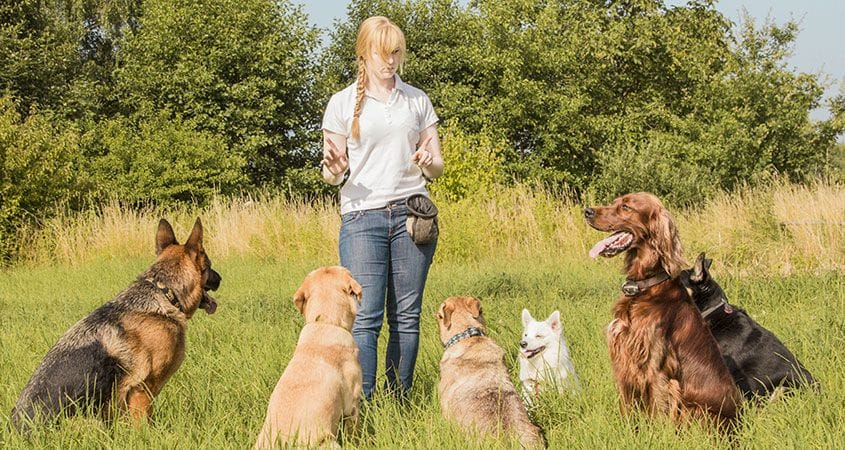What Factors Influence Dog Behavior?
Dog training is the application of behavior analysis that uses environmental events of antecedents (triggers for behavior) and consequences to modify the dog's behavior, either to assist in specific activities or undertake specific tasks or participate effectively in contemporaneous domestic life. A variety of factors come into play when evaluating dog behavior and making a careful assessment. A dog's personality and temperament, like that of humans, are the result of the interaction of genes and the environment. The nature vs. nurture debate also applies to the canine world. Is a dog's behavior the result of an inherent mix of genes, or is it the result of multiple experiences in this world? Both are very likely fundamental factors.
Dog daycare, also known as doggy daycare, is a type of daycare for dogs. It differs from multi-day kennel boarding and pet sitting, both of which involve the sitter visiting the pet at home. Dog daycare is similar to a regular daycare for children, with the exception that it is only for canines.
Francis Galton, an anthropologist, developed the expression "nature versus nurture." The idea stresses the significance of intrinsic characteristics above personal experiences. Dog behavioral features can be caused by one or both of these factors. There are several elements that might influence a dog's behavior, and they can be inherited or environmental in nature. The following are some of the most prevalent elements that might impact a dog's behavior.
Here are some illustrations of how a dog's basic nature might influence its behavior.
Genetic Factors
The qualities and characteristics acquired from their parents and handed down from earlier generations are referred to as the dog's genetic makeup. Many of their behaviors may be ascribed to their species, but keep in mind that they are dogs first and foremost. Humans have selectively bred each breed of dog for generations, resulting in breed-specific features.
Aside from qualities and characteristics determined by species and breed, each dog is an individual with its own distinct personality. Despite having the same parents, littermates will display a range of distinct behaviors within a single litter, ranging from personal preferences to tolerances to particular medical issues.
These genetic effects will have an impact on the dog's behavior throughout its life. We can't modify their DNA. Rather, we must work with the dog rather than against it to guarantee a happy and comfortable animal and a healthy human-dog connection.
Visit doggy daycare near me for dog care to keep your dog intellectually and physically busy during the day so that you may come home to a happy, contented, and rested dog.
Previous experiences and abilities
Dogs learn by experience. If people view the effect of their activities to be gratifying, they are more inclined to repeat the behavior in order to get the desired result. Alternatively, if they discover that a certain activity has a negative impact, they will actively avoid repeating such behaviors. The more regularly a dog performs a behavior (whether good or negative) that results in a beneficial consequence, the more imprinted this gets in the dog's brain, eventually leading to automatic behavior.
When establishing the source of a dog's behavior, it is critical to distinguish whether the dog is driven by a desire to do something positive or by a desire to avoid something undesirable. This difference is critical because it will have a direct impact on how we react to the behavior.
If the dog is striving to avoid anything undesirable, for example, providing punishment or reprimand would just increase the dog's tension and so deepen its acquired negative connection. Leash correction of a dog to keep calm and endure a dog's dislikes is an example of this. The leash discipline will just add to the stress level of an already stressed dog.If you want to teach your dog, look for Doggy training around me. From training the animal in healthy behaviors to giving it basic commands,
Understanding the rationale behind a dog's behavior allows us to discourage unwanted behaviors. Leaving food on a countertop within the dog's reach, for example, will simply encourage "stealing from the counter" because the consequence of this behavior is gratifying for the dog.
Current Situation
The dog's current habitat includes both its internal and exterior surroundings.
Their internal environment is concerned with their mental and bodily condition before and throughout a crisis. Anxiety and physical discomfort, for example, can both have an effect on their mental and physical well-being and drive individuals to react differently in a particular setting. From our vantage point, determining the interior environment might be challenging. As sociable creatures, dogs will frequently do anything they can to conceal physical suffering, making it more difficult to detect. A dog's mental and emotional state is impacted by both pleasure and stress. Stress might be triggered by a terrible incident, for example. However, it can also emerge more quietly as a result of a series of bad experiences (triggers) with insufficient recovery time in between. If leaving your dog at home gives you nightmares, consider the best dog hostel where they know how to groom the pet and take care of it in your absence.
The exterior environment might sometimes be difficult for a dog to comprehend. The world we live in is easier to comprehend from our vantage point because we, as humans, either made it or designed our lives around it. A dog has the cognitive aptitude of an 18-24month old kid and, as such, can never comprehend its surroundings in the same way that we do. Noise and mobility are the two key stimuli for dogs, and both are prevalent in city life. This can quickly overwhelm dogs, causing hypervigilance, reactivity, uneasiness, and anxiety.
Dogs form relationships throughout their surroundings. When the dog is exposed to the same situation again, the taught behavior is remembered and repeated. We, as owners, choose the surroundings our dogs are exposed to. As a result, we must be aware of the behaviors we want in these various contexts in order to educate our dogs on what is proper and what is not. We must be attentive to our dogs, interact with them on a regular basis, and reward calm behaviors if we want to develop a peaceful and pleasant relationship in a certain location. Don't be concerned about leaving your pet alone at home when you have to go away or work long hours. Have you ever thought to yourself, "Is there a puppy daycare near me that can help?" You can simply discover reputable dog daycare in your area.
If you're looking for Dog Training in Dubai, choose Zoomies, a cutting-edge Doggy Daycare, Dog Boarding, and Dog Training facility in Al Quoz Industrial Area. Zoomies offers various play areas for our dog daycare and dog boarding guests to enjoy. We guarantee that your dog will receive the finest possible care throughout their stay at Zoomies.

.png)
.png)

Comments
Post a Comment